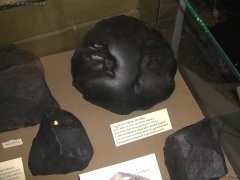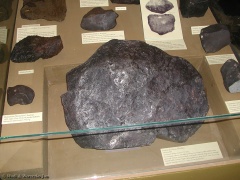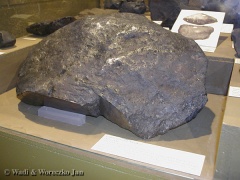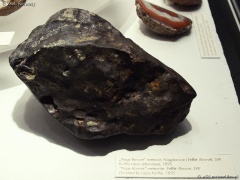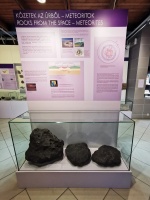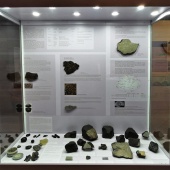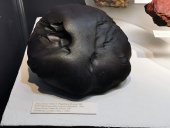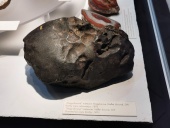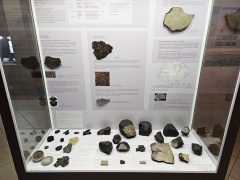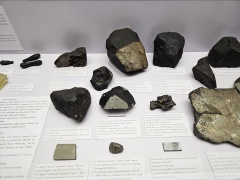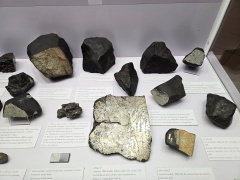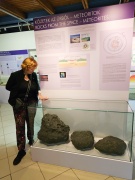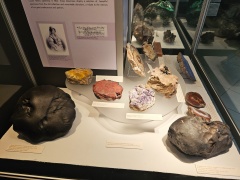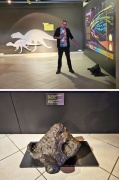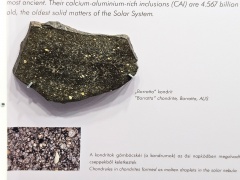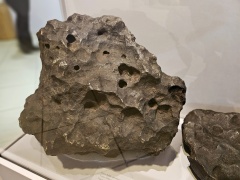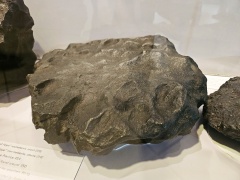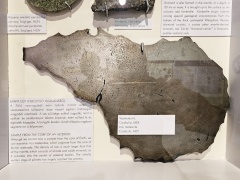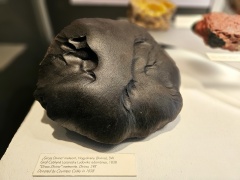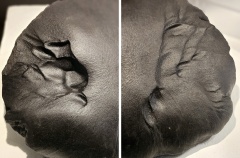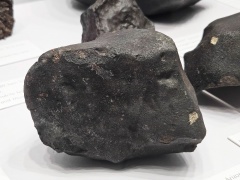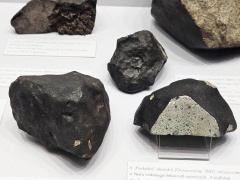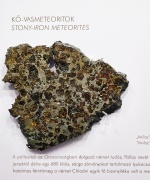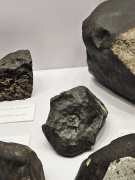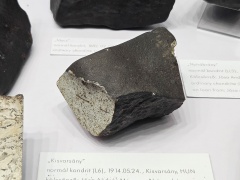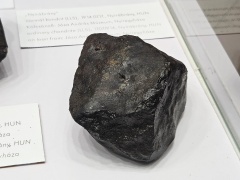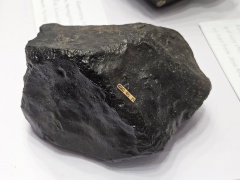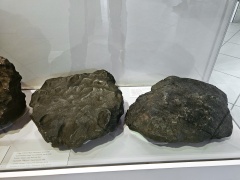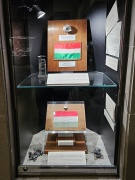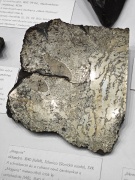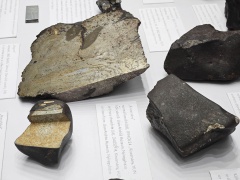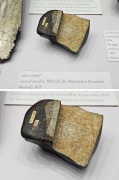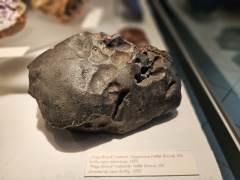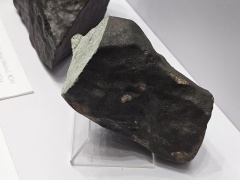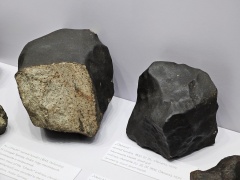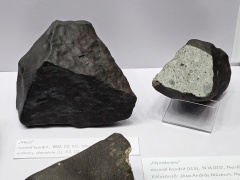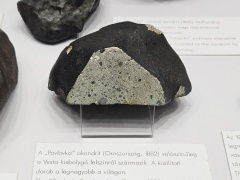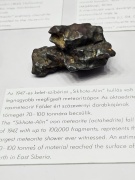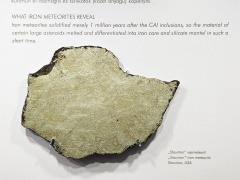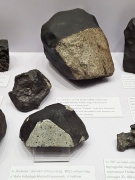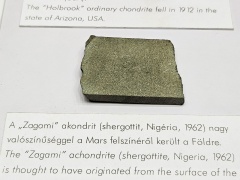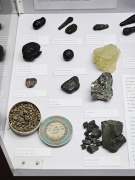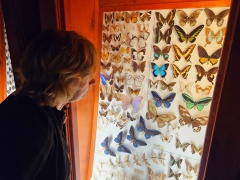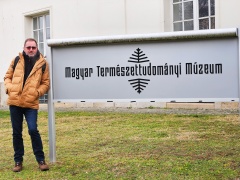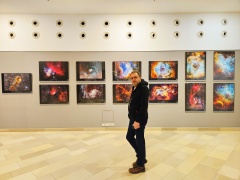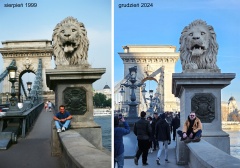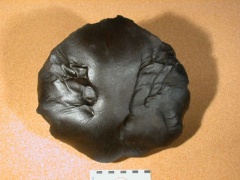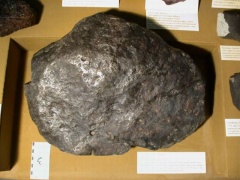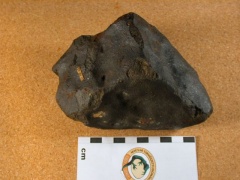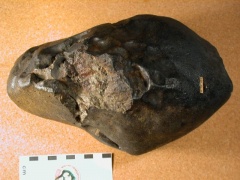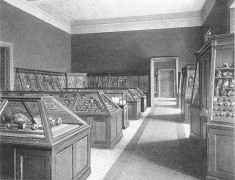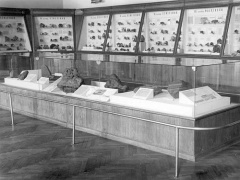(Unless otherwise stated, the copyright of the materials included belong to Jan Woreczko & Wadi.)
Szablon:BudapestNHM
Z Wiki.Meteoritica.pl
m (→2024) |
m (→Historia) |
||
| (Nie pokazano 5 wersji pomiędzy niniejszymi.) | |||
| Linia 1: | Linia 1: | ||
| - | '''[[Szablon:BudapestNHM|Muzeum Historii Naturalnej w Budapeszcie]]''' (Hungarian Natural History Museum, Budapest; ''Budapest, Nat. Mus.'') – [http://www.nhmus.hu/ Magyar Természettudományi Múzeum Budapest] {{SeparatorBull}} <del>[http://web.nhmus.hu/kutatas/adatbazisok/meteorit/tokody_katal_a.html Katalog Tokody (1951)] {{SeparatorBull}} [http://web.nhmus.hu/kutatas/adatbazisok/meteorit/metkarp_start_a.html Meteorites in the Carpatian Basin] (english); [http://web.nhmus.hu/kutatas/adatbazisok/meteorit/metkarp_start.html Kárpát-medencei meteoritok] (hungarian)</del> {{SeparatorBull}} [katalog → [[Szablon:Ravasz (1969)|Ravasz (1969)]]]<noinclude> | + | <noinclude>== Muzeum Historii Naturalnej w Budapeszcie == |
| + | </noinclude>'''[[Szablon:BudapestNHM|Muzeum Historii Naturalnej w Budapeszcie]]''' (Hungarian Natural History Museum, Budapest; ''Budapest, Nat. Mus.'') – [http://www.nhmus.hu/ Magyar Természettudományi Múzeum Budapest] {{SeparatorBull}} <del>[http://web.nhmus.hu/kutatas/adatbazisok/meteorit/tokody_katal_a.html Katalog Tokody (1951)] {{SeparatorBull}} [http://web.nhmus.hu/kutatas/adatbazisok/meteorit/metkarp_start_a.html Meteorites in the Carpatian Basin] (english); [http://web.nhmus.hu/kutatas/adatbazisok/meteorit/metkarp_start.html Kárpát-medencei meteoritok] (hungarian)</del> {{SeparatorBull}} [katalog → [[Szablon:Ravasz (1969)|Ravasz (1969)]]]<noinclude> | ||
__NOTOC__ | __NOTOC__ | ||
| Linia 72: | Linia 73: | ||
File:Budapeszt_(Woreczko)-2024.jpg|[[Woreczko]] | File:Budapeszt_(Woreczko)-2024.jpg|[[Woreczko]] | ||
File:Budapeszt_(Woreczko)-2024_1.jpg| | File:Budapeszt_(Woreczko)-2024_1.jpg| | ||
| - | File:Budapeszt_(Lanchid)-Woreczko.jpg|Wspomnienie sprzed lat: 1999 – [http://www.woreczko.pl/meteorites/observations/1999-SolarEclipse/SolarEclipse.htm wyprawa na całkowite zaćmienie Słońca, 11 sierpnia 1999 r.]; 2024 – wizyta w MHN | + | File:Budapeszt_(Lanchid)-Woreczko.jpg|Wspomnienie sprzed lat: 1999 – [http://www.woreczko.pl/meteorites/observations/1999-SolarEclipse/SolarEclipse.htm wyprawa na całkowite zaćmienie Słońca, 11 sierpnia 1999 r.]; 2024 – [http://www.woreczko.pl/meteorites/events/2024-Budapeszt/Budapeszt.htm wizyta w MHN] |
| + | </gallery> | ||
| + | |||
| + | |||
| + | == Historia == | ||
| + | |||
| + | Historia kolekcji wg WayBackMachine: | ||
| + | {{AQuote-begin |max-width=800px}} | ||
| + | '''Brief history of the meteorite collection in the Hungarian Natural History Museum''' | ||
| + | |||
| + | {{Txt2Img|Lenarto_(M.68.019)-WBM.jpg|The main mass (76,5 kg)}} of the 108,5-kg “Lenarto” iron meteorite fall (Lénártó, now Lenartov, Slovakia), donated by József Kapy, local landlord to the National Museum in 1815, was the first specimen in the collection. In 1838 the museum received the {{Txt2Img|Gross-Divina_(M.62.010)-WBM.jpg|“Gross-Divina”}} (Nagydivény, now Divina, Slovakia) stone due to the benevolence of Ludovika Lasanszky, widow of the local landholder, Count László Csáky. Later on a number of meteorite specimens from Hungarian falls arrived to the collection thanks to the generosity of individual donors as well. Materials were donated in 1853 by Vilmos Knöpfler, physician at Marosvásárhely (now Târgu Mureş, Romania) from the {{Txt2Img|Mezö-Madaras_(M.59.067)-WBM.jpg|“Mezö-Madaras”}} (Mezőmadaras, now Mădăraş, Romania); in 1858 by Prof. József Török of the Debrecen College from the “Kaba”; in 1866 by Jenő Őri, Deputy Lord Lieutenant of Ung County from the [[Knyahinya|“Knyahinya”]] (Csillagfalva, now Knyahynya in the Ukraine); in 1895 by Lajos Kürthy, Lord Lieutenant of Zólyom County from the {{Txt2Img|Nagy-Borové_(M.59.413)-WBM.jpg|“Nagy-Borové”}} (Nagyborove, now Veľké Borové, Szlovákia); in 1900 by Count József Mailáth, local landlord from the {{Txt2Img|Ofehértó_(M.60.048)-WBM.jpg|“Ofehértó”}} (Ófehértó) fall. | ||
| + | |||
| + | State and other institutions also contributed to the enrichment of the collection. In 1866 the Locotenential Council purchased a 73-pound (41.3 kg) stone from the “Knyahinya” meteorite shower; in 1868 the Hungarian Academy of Sciences gave seven specimens from foreign falls, obtained in exchange for specimens collected by the commission of the Academy on the site of the “Knyahinya” fall. | ||
| + | |||
| + | 67 meteorite specimens were held in the collection in 1876. Subsequent rapid development of the collection was first of all due to the financial aid of the unsurpassable patron of the museum, Andor Semsey (1833–1923). He showed a preference to the financial assistance of the meteorite collection, and increased its holdings altogether with some thousand pieces. Among them 456 specimens from the collection of the Dutch professor Eduard Hendrik von Baumhauer (1820–1885) and 214 specimens from the collection of Baron von Braun, Austrian state councillor. It was Semsey who compiled the [[Szablon:Semsey (1887)|first printed catalogue]] of the collection (1886, title page, first page), and he published a brief review of the collection in the journal ''Magyar Salon'' (1888). By the end of the Semsey and Krenner era (1919) the meteorite collection amounted to 1182 specimens. The best specimens were {{Txt2Img|Budapest_(kiallitas_1902)-WBM.jpg|exhibited}} in four display cabinets. | ||
| + | |||
| + | The collection moderately increased in the next decades, and in 1951, when László Tokody (using the manuscript catalogue taken by Mária Vendl in 1928) published his book on ''[[Szablon:Tokody (1951)|Meteorite collections in Hungary]]'', amounted to 1295 specimens from 484 falls. [https://web.archive.org/web/20050210171316/http://www.nhmus.hu/adatbazisok/meteorit/tokody_katal_a.html Click here] for the topographical part of the catalogue. Large specimens occupied a prominent place in the {{Txt2Img|Budapest_(kiallitas_1952)-WBM.jpg|new exhibition}} opened in 1952. | ||
| + | |||
| + | The conflagration of the museum in 1956 had a devastating effect on the meteorite collection, more than half of the specimens were destroyed. Rescued specimens were cleaned, freed from rust, conserved, determined and recatalogued by László Tokody and Mária Rapszky-Hanák between 1959–62. A minor increase of the collection after 1956 was due to a few domestic (Hungarian Geological Survey) and foreign (H. H. Nininger) donations, and occasional exchange. The new printed catalogue of the collection, was published in English by Csaba Ravasz in the first (1969) volume of ''[[Szablon:Ravasz (1969)|Fragmenta Mineralogica et Petrographica]]''. This catalogue gave information not only about the specimens themselves (inventory numbers, description, weight, size) but about the falls as well. This electronic catalogue is an amended and updated, bilingual (Hungarian and English) version of this latter catalogue. | ||
| + | {{AQuote-end}} | ||
| + | |||
| + | <gallery caption="" widths="240px" heights="180px" perrow="3"> | ||
| + | File:Gross-Divina_(M.62.010)-WBM.jpg|Gross-Divina | ||
| + | File:Lenarto_(M.68.019)-WBM.jpg|Lenarto | ||
| + | File:Mezö-Madaras_(M.59.067)-WBM.jpg|Mezö-Madaras | ||
| + | File:Nagy-Borové_(M.59.413)-WBM.jpg|Nagy-Borové | ||
| + | File:Ofehértó_(M.60.048)-WBM.jpg|Ofehértó | ||
| + | </gallery> | ||
| + | <gallery caption="" widths="240px" heights="180px" perrow="3"> | ||
| + | File:Budapest_(kiallitas_1902)-WBM.jpg|Ekspozycja 1902 rok | ||
| + | File:Budapest_(kiallitas_1952)-WBM.jpg|Ekspozycja 1952 rok | ||
| + | File:Lenarto_(NHM_Budapest)_g4.jpg|Ekspozycja 2004 rok (fot. Jan Woreczko) | ||
</gallery> | </gallery> | ||
| Linia 86: | Linia 118: | ||
== Linki zewnętrzne == | == Linki zewnętrzne == | ||
| + | |||
| + | * WayBackMachine – 10.02.2005: [https://web.archive.org/web/20050210112753/http://www.nhmus.hu/adatbazisok/meteorit/index_a.html Meteoritical database of the Hungarian Natural History Museum] | ||
* Facebook – galeria [https://www.facebook.com/kormos.balazs.9/media_set?set=a.999463410133582&type=3 Magyar Természettudományi Múzeum] (prowadzona przez Kormos Balázs) | * Facebook – galeria [https://www.facebook.com/kormos.balazs.9/media_set?set=a.999463410133582&type=3 Magyar Természettudományi Múzeum] (prowadzona przez Kormos Balázs) | ||
| + | |||
| + | * woreczko.pl – [http://www.woreczko.pl/meteorites/events/2024-Budapeszt/Budapeszt.htm Budapeszt 2024, MHN] | ||
[[Category:Kolekcje|{{PAGENAME}}]] | [[Category:Kolekcje|{{PAGENAME}}]] | ||
</noinclude> | </noinclude> | ||
Aktualna wersja na dzień 17:26, 7 lut 2025
Muzeum Historii Naturalnej w Budapeszcie
Muzeum Historii Naturalnej w Budapeszcie (Hungarian Natural History Museum, Budapest; Budapest, Nat. Mus.) – Magyar Természettudományi Múzeum Budapest ● Katalog Tokody (1951) ● Meteorites in the Carpatian Basin (english); Kárpát-medencei meteoritok (hungarian) ● [katalog → Ravasz (1969)]
Galerie
Okazy z kolekcji (stan: grudzień 2004 r.; fot. Wadi i Jan Woreczko)
Masa główna meteorytu Gross-Divina (oraz okazy: Mocs, Ofehértó) (fot. Wadi & Jan Woreczko) |
Meteoryt Knyahinya (fot. Wadi & Jan Woreczko) |
Meteoryt Lenarto (fot. Wadi & Jan Woreczko) |
Meteoryt Lenarto (fot. Wadi & Jan Woreczko) |
Meteoryt Lenarto (fot. Wadi & Jan Woreczko) |
Meteoryt Lenarto (fot. Wadi & Jan Woreczko) |
Meteoryt Mezö-Madaras (fot. Wadi & Jan Woreczko) |
Masa główna meteorytu Nagy-Borové (fot. Zsolt Kereszty) |
Masa główna meteorytu Nyirábrany (fot. Wadi & Jan Woreczko) |
Masa główna meteorytu Ofehértó (fot. Wadi & Jan Woreczko) |
Ekspozycja (stan: kwiecień 2023 r.; fot. Krzysztof Szopa)
Masa główna meteorytu Gross-Divina |
Masa główna meteorytu Nagy-Borové |
2024
(wagi wg katalogu Ravasz (1969))
Główna gablota z meteorytami: Allende, Barratta, Holbrook, Imilac, Jelica, Kisvarsány, Knyahinya, Magura, Mezö-Madaras, Minnichhof, Mocs, Mount Edith, Nyirábrany, Ofehértó, Pavlovka, Sikhote-Alin, Staunton, Utrecht, Zagami, tektyty, pseudometeoryty; mapa meteorytów węgierskich |
||
Gablota z dużymi okazami meteorytów żelaznych (od lewej): Canyon Diablo, Cape of Goog Hope i Lenarto |
Kolejna gablota, masy główne meteorytów Gross-Divina i Nagy-Borové |
Leżący na gumowej macie duży okaz (132,17 kg) meteorytu żelaznego Gibeon[1] |
Płytka (548,1 g) meteorytu Barratta |
Duży okaz (287 kg) meteorytu żelaznego Canyon Diablo[2] |
Okaz (66,9 kg) meteorytu żelaznego Cape of Goog Hope |
Pełna płyta (2,5 kg) meteorytu żelaznego Coahuila[3] |
Masa główna (9,91 kg) meteorytu Gross-Divina |
Szczegóły powierzchni orientowanego meteorytu Gross-Divina; regmaglipty i linie spływu (ang. flow lines) |
Okaz meteorytu Holbrook[4] (1,8 kg) |
Płytka meteorytu Imilac[6] |
|
Kompletny okaz (692 g) meteorytu Jelica |
Masa główna (1,55 kg) meteorytu Kisvarsány |
Kompletny okaz (1,16 kg) meteorytu Knyahinya |
Kompletny okaz (1,16 kg) meteorytu Knyahinya |
Okaz (66,9 kg) meteorytu żelaznego Cape of Goog Hope i (po prawej) masa główna (73,62 kg) meteorytu Lenarto |
|
Polerowany fragment (4,85 kg) meteorytu Magura |
Okaz (1068 g) meteorytu Mezö-Madaras (po prawej u góry); poniżej okaz meteorytu Kisvarsány, po lewej fragment meteorytu Magura i okaz meteorytu Minnichhof |
Masa główna (462,6 g) meteorytu Minnichhof |
Fragment (2,740 kg) meteorytu żelaznego Mount Edith |
Masa główna (5,880 kg) meteorytu Nagy-Borové |
Masa główna (1,108 kg) meteorytu Nyirábrany |
Okaz meteorytu Mocs i masa główna meteorytu Nyirábrany |
Masa główna (955 g) howardytu Pavlovka[5] |
|
Okaz meteorytu Sikhote-Alin[8] |
Kompletna płyta (~2,4 kg) meteorytu Staunton |
|
Płytka meteorytu Zagami[9] |
Zbiór tektytów (bilitonit, indochinit, mołdawity, rizalit, Szkło Darwina, Szkło Pustyni Libijskiej) i pseudometeorytów |
|
Wspomnienie sprzed lat: 1999 – wyprawa na całkowite zaćmienie Słońca, 11 sierpnia 1999 r.; 2024 – wizyta w MHN |
Historia
Historia kolekcji wg WayBackMachine:
Brief history of the meteorite collection in the Hungarian Natural History Museum
The main mass (76,5 kg) of the 108,5-kg “Lenarto” iron meteorite fall (Lénártó, now Lenartov, Slovakia), donated by József Kapy, local landlord to the National Museum in 1815, was the first specimen in the collection. In 1838 the museum received the “Gross-Divina” (Nagydivény, now Divina, Slovakia) stone due to the benevolence of Ludovika Lasanszky, widow of the local landholder, Count László Csáky. Later on a number of meteorite specimens from Hungarian falls arrived to the collection thanks to the generosity of individual donors as well. Materials were donated in 1853 by Vilmos Knöpfler, physician at Marosvásárhely (now Târgu Mureş, Romania) from the “Mezö-Madaras” (Mezőmadaras, now Mădăraş, Romania); in 1858 by Prof. József Török of the Debrecen College from the “Kaba”; in 1866 by Jenő Őri, Deputy Lord Lieutenant of Ung County from the “Knyahinya” (Csillagfalva, now Knyahynya in the Ukraine); in 1895 by Lajos Kürthy, Lord Lieutenant of Zólyom County from the “Nagy-Borové” (Nagyborove, now Veľké Borové, Szlovákia); in 1900 by Count József Mailáth, local landlord from the “Ofehértó” (Ófehértó) fall.
State and other institutions also contributed to the enrichment of the collection. In 1866 the Locotenential Council purchased a 73-pound (41.3 kg) stone from the “Knyahinya” meteorite shower; in 1868 the Hungarian Academy of Sciences gave seven specimens from foreign falls, obtained in exchange for specimens collected by the commission of the Academy on the site of the “Knyahinya” fall.
67 meteorite specimens were held in the collection in 1876. Subsequent rapid development of the collection was first of all due to the financial aid of the unsurpassable patron of the museum, Andor Semsey (1833–1923). He showed a preference to the financial assistance of the meteorite collection, and increased its holdings altogether with some thousand pieces. Among them 456 specimens from the collection of the Dutch professor Eduard Hendrik von Baumhauer (1820–1885) and 214 specimens from the collection of Baron von Braun, Austrian state councillor. It was Semsey who compiled the first printed catalogue of the collection (1886, title page, first page), and he published a brief review of the collection in the journal Magyar Salon (1888). By the end of the Semsey and Krenner era (1919) the meteorite collection amounted to 1182 specimens. The best specimens were exhibited in four display cabinets.
The collection moderately increased in the next decades, and in 1951, when László Tokody (using the manuscript catalogue taken by Mária Vendl in 1928) published his book on Meteorite collections in Hungary, amounted to 1295 specimens from 484 falls. Click here for the topographical part of the catalogue. Large specimens occupied a prominent place in the new exhibition opened in 1952.
The conflagration of the museum in 1956 had a devastating effect on the meteorite collection, more than half of the specimens were destroyed. Rescued specimens were cleaned, freed from rust, conserved, determined and recatalogued by László Tokody and Mária Rapszky-Hanák between 1959–62. A minor increase of the collection after 1956 was due to a few domestic (Hungarian Geological Survey) and foreign (H. H. Nininger) donations, and occasional exchange. The new printed catalogue of the collection, was published in English by Csaba Ravasz in the first (1969) volume of Fragmenta Mineralogica et Petrographica. This catalogue gave information not only about the specimens themselves (inventory numbers, description, weight, size) but about the falls as well. This electronic catalogue is an amended and updated, bilingual (Hungarian and English) version of this latter catalogue.
Bibliografia
- Ravasz Csaba, (1969), Catalogue of Meteorites of the Hungarian Natural History Museum, Fragmenta Mineralogica et Palaeontologica, 1, 1969, s. 3-110.[10] Plik PDF;
plik PDF.
- Semsey Andor, (1887), A Magyar Nemzeti Muzeum Meteorit-gyüjteménye, Földtani közlöny, 17(4-6), 1887, s. 191-200. Plik DjVu; plik PDF.
- Tokody László, Dudichné Vendl Mária, (1951), Magyarország meteoritgyűjteményei (Meteorite collections in Hungary), Akadémiai Kiadó, Budapest 1951, ss. 102. Plik
GIF; plik GIF.
Przypisy
Linki zewnętrzne
- WayBackMachine – 10.02.2005: Meteoritical database of the Hungarian Natural History Museum
- Facebook – galeria Magyar Természettudományi Múzeum (prowadzona przez Kormos Balázs)
- woreczko.pl – Budapeszt 2024, MHN
